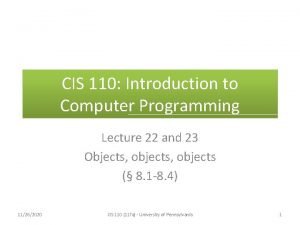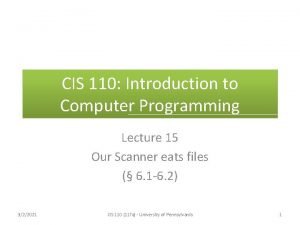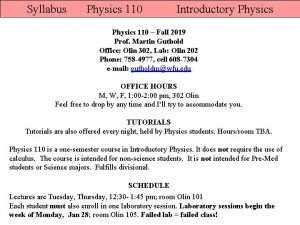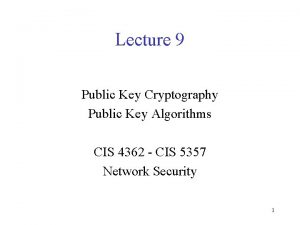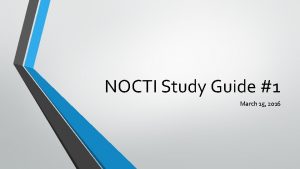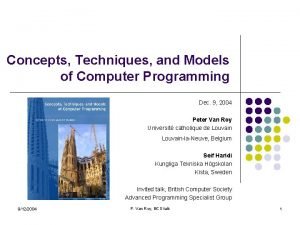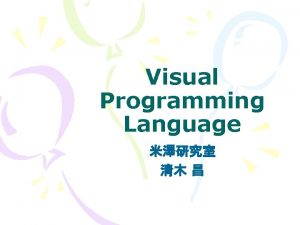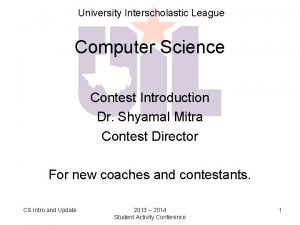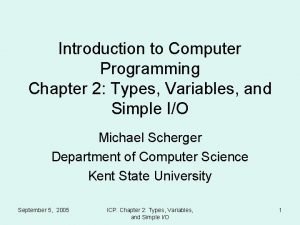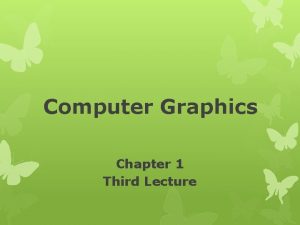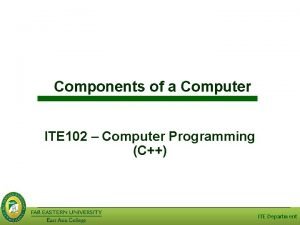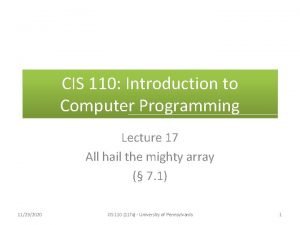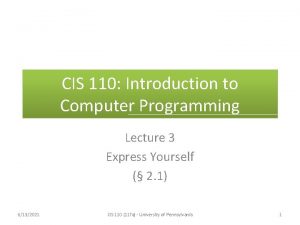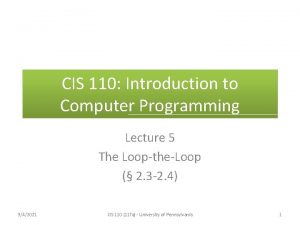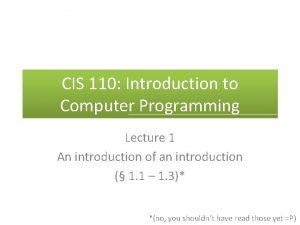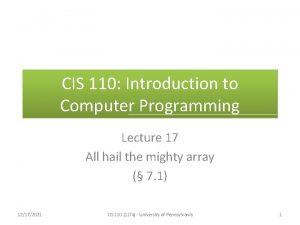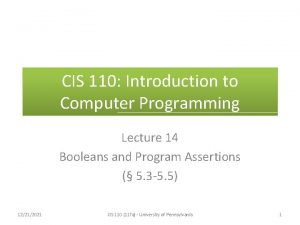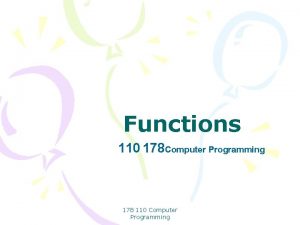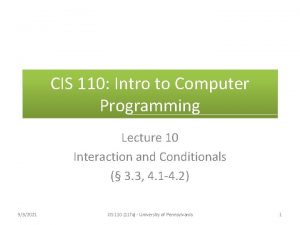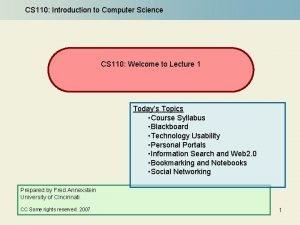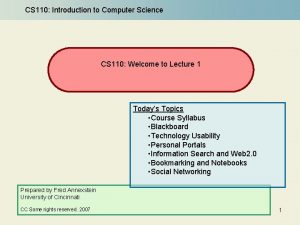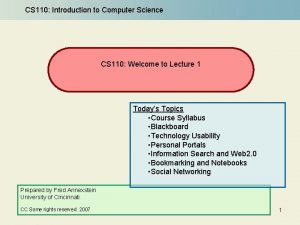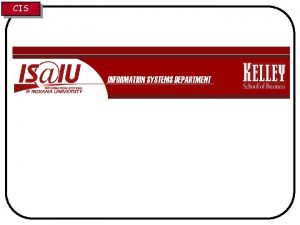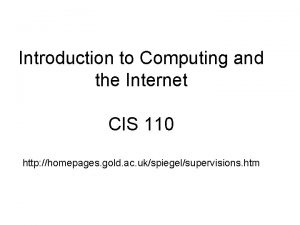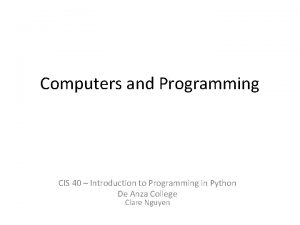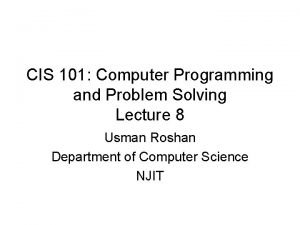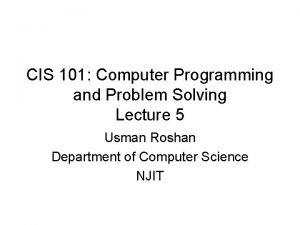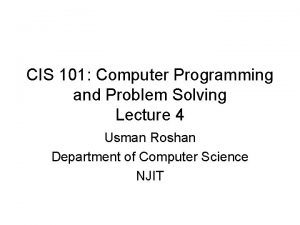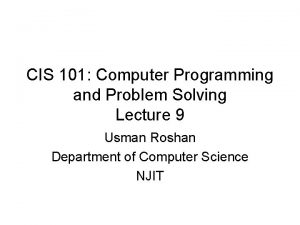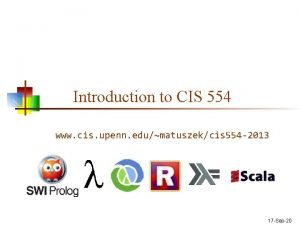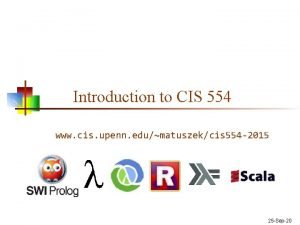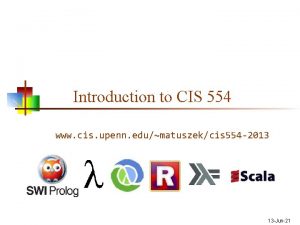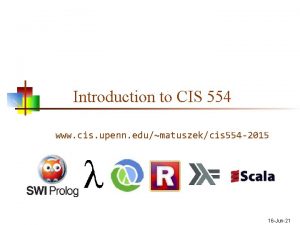CIS 110 Introduction to Computer Programming Lecture 15














![An exceptional problem public static void main(String[] args) { Scanner file = new Scanner(new An exceptional problem public static void main(String[] args) { Scanner file = new Scanner(new](https://slidetodoc.com/presentation_image_h/1f8c75cb09539bf909dadb75d04db7ab/image-15.jpg)













- Slides: 28

CIS 110: Introduction to Computer Programming Lecture 15 Our Scanner eats files (§ 6. 1 -6. 2) 3/2/2021 CIS 110 (11 fa) - University of Pennsylvania 1

Outline • Programming assertion recap • The Scanner object and files • Token-based file processing 3/2/2021 CIS 110 (11 fa) - University of Pennsylvania 2

Exam announcements • Attempting to reschedule midterm #2 to 11/21 (Monday of Thanksgiving break) – Let me know asap if you will be out of town. • Final time has been confirmed for 12/19, 6 -8 PM – Let me know asap if you need to reschedule. 3/2/2021 CIS 110 (11 fa) - University of Pennsylvania 3

Programming assertions revisited 3/2/2021 CIS 110 (11 fa) - University of Pennsylvania 4

An extended example: mystery public static int mystery(int n) { int x = 0; // Point A if (n < 0) { return -1; } while (n != 0) { // Point B int d = n % 10; if (d % 2 == 1) { x += d; } // Point C n /= 10; } // Point D return x; } 3/2/2021 For each point, are the following always/sometimes/never true? 1) n < 0 2) x >= 0 3) d < 10 4) x < n (See Assertion. Problem. java. ) CIS 110 (11 fa) - University of Pennsylvania 5

The Scanner object and files 3/2/2021 CIS 110 (11 fa) - University of Pennsylvania 6

Scanners revisited • A Scanner is a faucet over some pipe of data. Scanner 3/2/2021 CIS 110 (11 fa) - University of Pennsylvania System. in 7

Empty pipes • If the pipe is empty, the scanner first gets a line of input from the user, e. g. , one call to next(). Scanner System. in Hello world! 42n 3/2/2021 CIS 110 (11 fa) - University of Pennsylvania 8

Consuming input from the pipe • The call to next() then consumes the first token of input. Scanner System. in world! 42n Hello 3/2/2021 (Token = chunk of text separated by whitespace) CIS 110 (11 fa) - University of Pennsylvania 9

Consuming tokens • When we consume a token, there's no way to "go back", only forward! Scanner System. in 42n world! Hello 3/2/2021 CIS 110 (11 fa) - University of Pennsylvania 10

Consuming tokens as different types • We can consume a token and translate it to a particular type, e. g. , next. Int(). Scanner System. in n 42 world! Hello 3/2/2021 CIS 110 (11 fa) - University of Pennsylvania 11

Consuming the rest of a line • We can consume the rest of a line with next. Line(). Scanner System. in n n 42 world! 3/2/2021 Hello CIS 110 (11 fa) - University of Pennsylvania 12

Plugging in different data sources • A Scanner can accept many kinds of data sources such as Files instead! Scanner File Scanner file = new Scanner(new File("data. txt")); 3/2/2021 CIS 110 (11 fa) - University of Pennsylvania 13

The File object • A File object represents a file or directory on disk. – Exists in the java. io package. File file = new File("data. txt"); System. out. println("can. Read? " + file. can. Read()); System. out. println("exists? " + file. exists()); // Renames the file to the given file's name. file. rename. To(new File("foo. txt")); // Deletes the file from disk if it exists. file. delete(); File 3/2/2021 CIS 110 (11 fa) - University of Pennsylvania 14
![An exceptional problem public static void mainString args Scanner file new Scannernew An exceptional problem public static void main(String[] args) { Scanner file = new Scanner(new](https://slidetodoc.com/presentation_image_h/1f8c75cb09539bf909dadb75d04db7ab/image-15.jpg)
An exceptional problem public static void main(String[] args) { Scanner file = new Scanner(new File("data. txt")); } • The following code fails to compile. Why? – "unreported exception java. io. File. Not. Found. Exception; must be caught or declared to be thrown" • Example of a checked exception in Java. 3/2/2021 CIS 110 (11 fa) - University of Pennsylvania 15

Checked and unchecked exceptions • Java distinguishes between two sorts of exceptions. – Unchecked exceptions represent program bugs – Checked exceptions represent badness outside of the program's control. Unchecked exceptions Index. Out. Of. Bounds. Exception Illegal. Argument. Exception Stack. Overflow. Error 3/2/2021 Checked exceptions File. Not. Found. Exception CIS 110 (11 fa) - University of Pennsylvania 16

Dealing with checked exceptions • Two solutions: – Annotate the enclosing method with a throws clause. – Use a try-catch block. public static void main(String[] args) throws File. Not. Found. Exception { Scanner file = new Scanner(new File("data. txt")); } Which do we use!? try { Scanner file = new Scanner( new File("data. txt")); } catch (File. Not. Found. Exception ex) { ex. print. Stack. Trace(); } 3/2/2021 CIS 110 (11 fa) - University of Pennsylvania 17

Checked exceptions: a holy war • Big debate if checked exceptions are "worth it". • General advice: use try-catch when you can do something meaningful with the exception. – Give a good error message, re-throw, etc. • For this class: we'll use throws clauses. public static void main(String[] args) throws File. Not. Found. Exception { Scanner file = new Scanner(new File("data. txt")); } 3/2/2021 CIS 110 (11 fa) - University of Pennsylvania 18

Token-based processing 3/2/2021 CIS 110 (11 fa) - University of Pennsylvania 19

Abstraction at its finest • The methods of the Scanner we've learned so far apply when we use a File instead! Scanner File Scanner file = new Scanner(new File("data. txt")); 3/2/2021 CIS 110 (11 fa) - University of Pennsylvania 20

File processing example: File. Sum import java. util. *; // Necessary since File. Not. Found. Exception is also in java. io. import java. io. *; public class File. Sum { public static void main(String[] args) throws File. Not. Found. Exception { Scanner file = new Scanner(new File("data. txt")); double sum = 0. 0; while(file. has. Next. Double()) { double d = file. next. Double(); System. out. println("Adding up " + d + ". . . "); sum += d; } System. out. println("Total = " + sum); } } 3/2/2021 CIS 110 (11 fa) - University of Pennsylvania 21

A file is just a long-ass string data. txt 3. 4 7. 1 4. 3 5. 9 1. 1 2. 5 3. 6 3. 4 -1. 2 7. 1 4. 3n 5. 9 1. 1 2. 5nnn 3. 6 We can think of a file as a sequence of characters by replacing newlines with 'n' -1. 2n while(file. has. Next. Double()) { double d = file. next. Double(); } 3/2/2021 CIS 110 (11 fa) - University of Pennsylvania 22

Input cursor 3. 4 7. 1 4. 3n 5. 9 1. 1 2. 5nnn 3. 6 Input cursor The input cursor is our current position in the file, initially at the beginning. data. txt 3/2/2021 -1. 2n while(file. has. Next. Double()) { double d = file. next. Double(); } CIS 110 (11 fa) - University of Pennsylvania 23

Input cursor and input consumption 3. 4 7. 1 4. 3n 5. 9 1. 1 2. 5nnn 3. 6 On each call to next. Double, we consume the next double and advance the input just past the token. Input cursor data. txt 3/2/2021 -1. 2n while(file. has. Next. Double()) { double d = file. next. Double(); } CIS 110 (11 fa) - University of Pennsylvania 24

Jumping that whitespace 3. 4 7. 1 4. 3n 5. 9 1. 1 2. 5nnn 3. 6 Calls to next. X() skip whitespace to the next token. Input cursor data. txt 3/2/2021 -1. 2n while(file. has. Next. Double()) { double d = file. next. Double(); } CIS 110 (11 fa) - University of Pennsylvania 25

Newlines are whitespace 3. 4 7. 1 4. 3n 5. 9 1. 1 2. 5nnn 3. 6 -1. 2n Input cursor data. txt 3/2/2021 while(file. has. Next. Double()) { double d = file. next. Double(); } CIS 110 (11 fa) - University of Pennsylvania 26

has. Next. X looks ahead 3. 4 7. 1 4. 3n 5. 9 1. 1 2. 5nnn 3. 6 has. Next. Double() now returns false! data. txt 3/2/2021 -1. 2n Input cursor while(file. has. Next. Double()) { double d = file. next. Double(); } CIS 110 (11 fa) - University of Pennsylvania 27

Mixing up types • We can mix different next. X functions as necessary. Jerry 21 13. 7 true file. next(); file. next. Int(); file. next. Double(); But we get No. Such. Element. Exception if we're wrong! 3/2/2021 file. next. Booelean(); CIS 110 (11 fa) - University of Pennsylvania 28
 Numero niss
Numero niss 100 011
100 011 Cis 110 upenn
Cis 110 upenn Cis 110 syllabus
Cis 110 syllabus 01:640:244 lecture notes - lecture 15: plat, idah, farad
01:640:244 lecture notes - lecture 15: plat, idah, farad Python programming an introduction to computer science
Python programming an introduction to computer science Introduction to physics 110
Introduction to physics 110 C programming lecture
C programming lecture Cis 4362 introduction to cryptology
Cis 4362 introduction to cryptology Perbedaan linear programming dan integer programming
Perbedaan linear programming dan integer programming Greedy programming vs dynamic programming
Greedy programming vs dynamic programming System programming
System programming Linear vs integer programming
Linear vs integer programming Programing adalah
Programing adalah Computer security 161 cryptocurrency lecture
Computer security 161 cryptocurrency lecture Computer aided drug design lecture notes
Computer aided drug design lecture notes Computer architecture notes
Computer architecture notes Isa definition computer
Isa definition computer Introduction to biochemistry lecture notes
Introduction to biochemistry lecture notes Introduction to psychology lecture
Introduction to psychology lecture Introduction to algorithms lecture notes
Introduction to algorithms lecture notes Nocti computer programming
Nocti computer programming What is nano programming
What is nano programming Concepts, techniques and models of computer programming
Concepts, techniques and models of computer programming Visual computer programming
Visual computer programming Uil computer science programming problems
Uil computer science programming problems Types of variables in computer programming
Types of variables in computer programming Programming raster display system in computer graphics
Programming raster display system in computer graphics Computerite
Computerite


